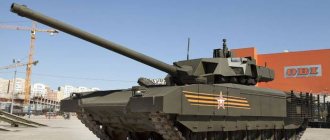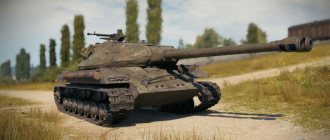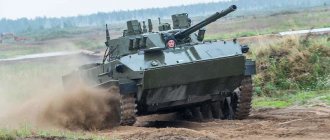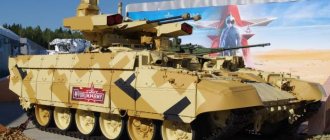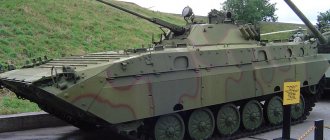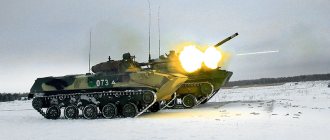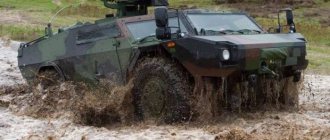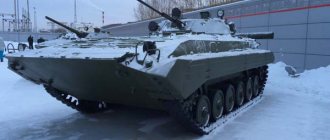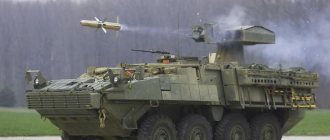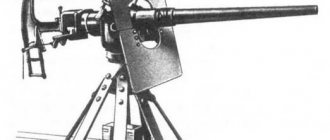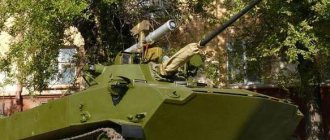In 1956, Nikita Sergeevich Khrushchev instructed the designers to begin work on a project for a unique tank that was not afraid of an atomic explosion, radiation contamination of the crew, or chemical or biological attacks. The project received article number 279. And such a heavy tank weighing 60 tons was designed by 1957 at SKB-2 of the Kirov Plant of Leningrad (KZL) under the leadership of the chief designer, Major General Joseph Yakovlevich Kotin. It was immediately and rightly called atomic. Moreover, the lion's share of its weight was armor, in some places reaching up to 305 millimeters. That is why the internal space for the crew was much smaller than that of heavy tanks of similar weight.
The atomic tank embodied new tactics for waging World War III and a more “vegetarian” era, when human life was at least worth something. It was the concern for the crew of this armored vehicle that dictated some of the tactical and technical data of this tank. For example, if necessary, the hermetically sealed turret hatch and gun breech prevented even a speck of dust from entering the interior of the vehicle, not to mention radioactive gases and chemical agents of contamination. Bacteriological danger was also excluded for tankers.
Thus, even the sides of the hull were protected by almost twice as thick armor as the German Tigers. It reached 182 mm on the 279th. The frontal armor of the hull generally had an unprecedented thickness - from 258 to 269 mm. This exceeded the parameters of even such a cyclopean German development of the Third Reich as the heaviest monster in the history of tank building, as if jokingly called by its developer Ferdinand Porsche Maus (“Mouse”). With a vehicle weight of 189 tons, its frontal armor was 200 mm. Whereas in an atomic tank it was simply covered with impenetrable 305 mm high-alloy steel. Moreover, the body of the Soviet miracle tank was shaped like a turtle shell - shoot, don’t shoot, and the shells simply slipped off it and flew on. In addition, the giant’s body was also covered with anti-cumulative shields.
American developments
So, the concept of nuclear tanks began to develop in the United States at the Question Mark III conference in Detroit in June 1954. It was assumed that the nuclear reactor would make the power reserve practically unlimited and allow the equipment to be combat-ready even after long marches. Two options were developed, the first proposed a special machine that would supply power to others during a long drive. The second option involved creating a tank with a nuclear reactor inside, protected on all sides by powerful armor.
* * *
Every year, humanity is getting closer and closer to the subjection of atomic energy. Oil reserves on Earth are limited, coal reserves are also limited, but radioactive fuel will last for tens of thousands of years, even if used uneconomically. The main thing is to learn how to use this dangerous energy wisely.
The history of nuclear energy began not so long ago. 100 years ago we did not know what it was, and 60 years ago we only knew how to destroy it with its help. Today the nuclear industry is the future. And who knows, maybe cars with compact nuclear engines will actually run on the roads of the 22nd century. And there will be monuments to the creators of the first Ford concepts on every corner.
TV-1 and TV-8
As a result of the development of the second result, the TV-1 project weighing 70 tons and frontal armor 350 mm appeared. The power plant consisted of a reactor and a turbine, and was capable of operating for more than 500 hours without refueling. The tank was armed with a 105 mm T140 cannon and several machine guns.
In August 1955, a conference was held under the number Question Mark IV, at which an improved and lightweight R32 project appeared, characterized by a weight reduced by 20 tons, 120 mm armor located at a high angle and a 90 mm T208 gun. The tank was protected at the level of contemporary medium tanks, but had a power reserve of more than 4,000 without refueling. As in the case of its predecessor, the matter was limited to the project.
It was planned to convert the M103 into a nuclear tank for various tests, but the vehicle was never built.
Also in the United States, they created an interesting nuclear tank, the Chrysler TV-8, which accommodates the crew and most of the mechanisms along with a nuclear reactor inside a huge tower mounted on a maximally reduced body with electric motors driving it inside. To be fair, it is worth noting that the first version of the tank was equipped with a 300-horsepower eight-cylinder diesel engine driving a generator. In addition to its unusual appearance, the TV-8 was supposed to float due to the displacement of the turret. It was armed with a 90 mm T208 cannon and 2 7.62 machine guns. A very progressive solution for its time was the installation of external cameras designed to save the crew’s eyes from flashes of explosions outside.
Chapter 3. Ariel Atom (2010)
An eternity passed before human imagination again turned to nuclear cars. But this time it was not engineers who got down to business, but designers. Fortunately, today any self-respecting 3D artist considers it necessary to draw a couple of cars of an original design.
Singaporean designer Muhammad Imran was inspired by two cars. The first is the Ford Seattle-ite XXI, and the second is the lightweight English sports car Ariel Atom, produced by a small company from Somerset. The sports car has a rather strange layout: it has no doors, roof, or luggage compartment; it is made on the basis of a rigid tubular exoskeleton and is equipped with a powerful 245-horsepower Honda engine. Due to its low weight, the Ariel Atom is capable of accelerating to 100 km/h in a fantastic 2.8 seconds.
Singaporean designer Muhammad Imran's Ariel Atom is futuristic but impossible
Ariel Atom by Muhammad Imran is different from both “prototypes”. The designer sought to make his concept as compact as possible. In this regard, he placed the two passengers of the car not side by side, but one after the other, with the driver’s legs reaching almost to the front bumper (from the inside, of course). According to Muhammad's idea, the isolated reactor should be located at the rear of the machine. True, Imran's technical training is somewhat confusing. For example, beautiful exhaust pipes in the form of a radiation hazard sign look impressive, but why does a nuclear car need an exhaust system as such? In any case, the Singaporean's concept will remain a beautiful concept, part of his portfolio.
The serial Ariel Atom is produced in Somerset and has nothing to do with nuclear energy
But not everything is so sad. Because six months after Imran’s sketches, a nuclear car, developed by a real group of scientists and quite possible in the conditions of modern technological development, appeared in the news.
Soviet developments
Work was also carried out in the USSR, although less actively. It is sometimes believed that a Soviet nuclear tank was created on the basis of the T-10, built in metal and tested, but this is not true. In 1961, TPP-3 was built and put into operation, which is a transportable nuclear power plant that moved on an extended heavy tank chassis and provided power to itself along with power to military and civilian facilities in the Far North and Siberia.
It is worth mentioning once again the so-called Object 279 nuclear war tank, which in fact is unlikely to be able to withstand an explosion and protect its crew.
Also sometimes I remember a certain tank with nuclear shells. Probably, it can be called the T-64A, with a launcher installed in the turret, capable of firing both conventional TURS and tactical missiles with a nuclear charge. This combat vehicle was called Taran, had a mass of 37 tons, a crew of 3 people and was intended to disable enemy forces from a distance beyond their reach.
Despite the abundance of projects, a nuclear tank was never created. Why? If only because the slightest damage in battle turned it into a small nuclear bomb, guaranteed to destroy its crew and allies around. Even without damage, the crew had to be constantly changed to avoid excessive radiation exposure. Such shortcomings turned out to be critical and even in our time there is no way to overcome them.
The armor is strong at 300 millimeters
And such a heavy tank weighing 60 tons was designed by 1957 at SKB-2 of the Kirov Plant of Leningrad (KZL) under the leadership of the chief designer, Major General Joseph Yakovlevich Kotin. It was immediately and rightly called atomic. Moreover, the lion's share of its weight was armor, in some places reaching up to 305 millimeters. That is why the internal space for the crew was much smaller than that of heavy tanks of similar weight.
The atomic tank embodied new tactics for waging World War III and a more “vegetarian” era, when human life was at least worth something. It was the concern for the crew of this armored vehicle that dictated some of the tactical and technical specifications of this tank. For example, if necessary, the hermetically sealed turret hatch and gun breech prevented even a speck of dust from entering the interior of the vehicle, not to mention radioactive gases and chemical agents of contamination. Bacteriological danger was also excluded for tankers.
Thus, even the sides of the hull were protected by almost twice as thick armor as the German Tigers. It reached 182 mm on the 279th. The frontal armor of the hull generally had an unprecedented thickness - from 258 to 269 mm. This exceeded the parameters of even such a cyclopean German development of the Third Reich as the heaviest monster in the history of tank building, as if jokingly called by its developer Ferdinand Porsche Maus (“Mouse”). With a vehicle weight of 189 tons, its frontal armor was 200 mm. Whereas in an atomic tank it was simply covered with impenetrable 305 mm high-alloy steel. Moreover, the body of the Soviet miracle tank was shaped like a turtle shell - shoot, don’t shoot, and the shells simply slipped off it and flew on. In addition, the giant’s body was also covered with anti-cumulative shields.
"Centurion" vs "Hiroshima"
By October 1953, a village and airstrip had been built at the Emu training ground in southern Australia. As part of Operation Totem, the British were going to test versions of the Blue Danube with reduced power. At the same time, they decided to check how an atomic explosion would affect a tank and an airplane, as well as a bunch of different things, including tubes of toothpaste.
"Centurion" mk. III (photo source)
For testing, the 1st Armored Regiment of the Australian Army took the recently delivered Centurion Mk. III type “K” under number 169041. Its delivery from the Pakapunyal base near Melbourne to the remote wastelands, where kangaroos are afraid to jump, turned out to be a non-trivial task.
The tank was transported by train to the nearest railway station to Woomera, from where a convoy of an M19 tank tractor with a Centurion and a jeep with personnel, spare parts and everything else moved along the road to the center of the training ground.
There the road ended, and ahead there were another 300 miles of rough roads and gullies. Their acceleration was reminiscent of something out of Mad Max. Periodically, the tank and the tractor had to change places: the Centurion pulled the truck on a trailer. With them came two trucks and another jeep that had joined them in Woomera. It only got worse from there. For the last 170 miles, the crew, led by Captain Monaghan, had to travel entirely on tracks through bushes and potholes, occasionally catching the tractor.
The tank is delivered to the testing site
And finally, the “Emu” point.
On October 15, the Centurion was fully equipped for combat: full ammunition, fuel, crew dummies, a running engine, closed hatches. It was placed 350 yards from a 30-meter tower with the Blue Danube, prepared for a ten-kiloton explosion.
When the radioactive mushroom blew into the wasteland, British scientists and military personnel were quite surprised.
The shock wave moved the car five feet and slightly to the left, tearing off fragile elements like mud covers and antennas. The hatches were thrown open by pressure, and the damage to the mannequins indicated that the people would not have survived. The hull was filled with radioactive sand and the optics were damaged.
A piece of armor torn off by an explosion
However, otherwise the tank, which was three hundred meters from the atomic explosion, was completely fine. Even the engine turned off only after the fuel supply was exhausted.
